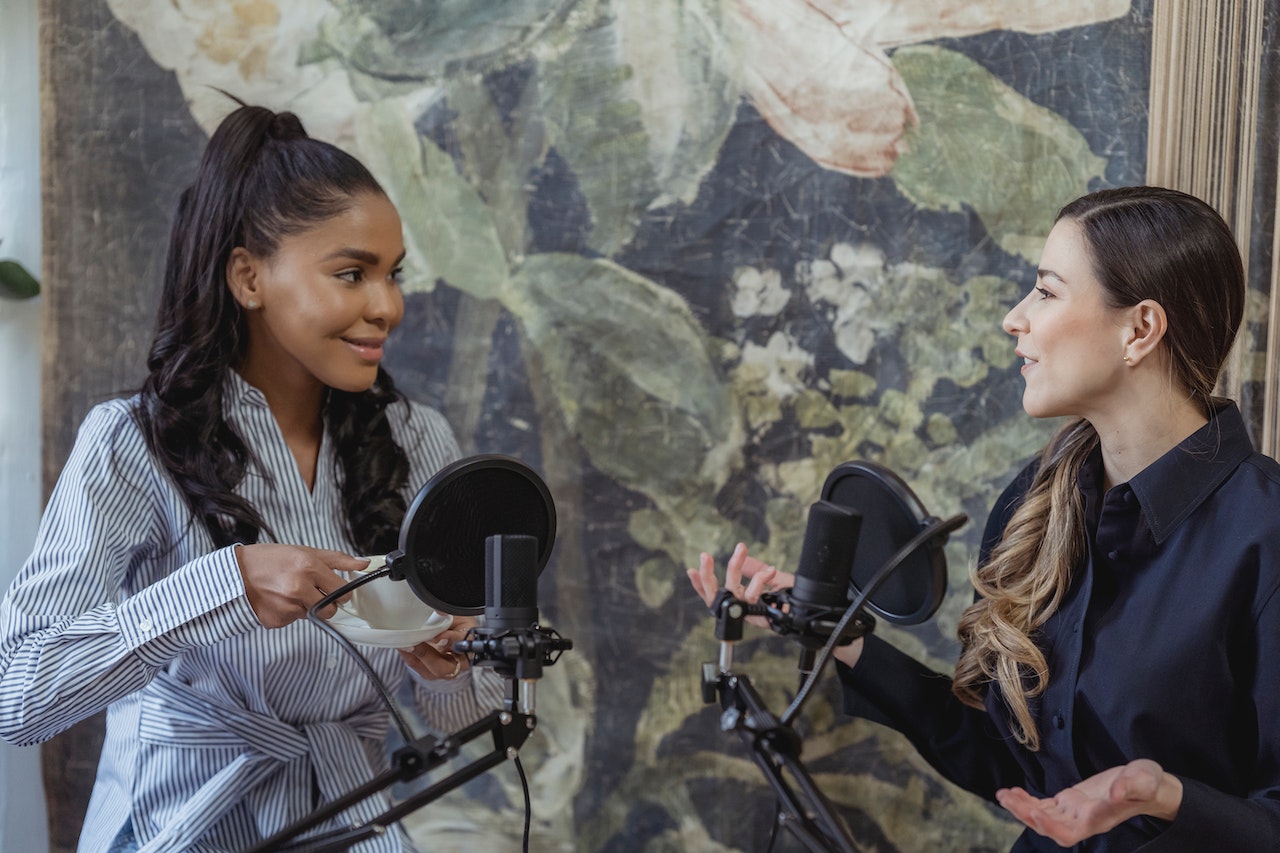How to Create a Popular Podcast for Your eCommerce or Retail Business
August 29, 2022 - 12 minutes readWhat you need to know to get started with your podcast.
If you’re looking to expand your commercial reach while sharing thought-leading insights and ideas with your audience, starting a podcast could be the way to go.
One hundred four million people in the US alone listen to podcasts every month—with 79.8% tuning in during their morning or evening commute.
As a retail or eCommerce business owner, starting a podcast will give you the tools to tap into a wider audience and drive people to your website, products, and services.
One of the most powerful aspects of a podcast is the fact that it gives you the chance to showcase your brand personality while talking about interesting issues related to your niche or industry. When you inspire people with your discussions, you will build trust.
Audio content holds the average consumer’s attention for longer, which means you have a greater chance of people remembering you and what you have to offer.
But if you want to enjoy a healthy return on investment (ROI) for your podcasting efforts, getting every stage of the process right is essential. We’re going to show you how to create a brand-boosting podcast for your business.
1. Choose your niche and subject matter
To create a brand-boosting podcast for your retail or eCommerce business, you need to choose a niche based on the trends, news, or topics that will keep your audience tuning in for more.
Naturally, you’re going to pick a retail topic based on the types of services or products you sell. But by taking the time to understand what your audience wants, you can dig a little deeper and choose a hook or subject matter that really stands out.
Gathering feedback from existing consumers is a great idea. For instance, you can incentivize people with a discount code in return for filling out a “What would you like to listen to?” survey after making a purchase. Market research groups will also give you a greater insight into the marketplace and what is likely to make your target listeners tick.
Once you’ve carried out some market research, you can narrow down your niche slightly based on the feedback and data you’ve collected.
If you’re a vintage shoe store, for example, and you’ve discovered that many of your listeners want to become official collectors—your podcast could revolve around the history of certain shoes and sneakers while offering expert tips on what to look for in profitable products.
The point: The more unique your niche or subject matter, the more likely you are to spark interest and stand out from the competition. And even if you lead with a unique niche, you can still find time to talk about regular industry news, topics, or trends if you feel they’re relevant (it’s a win-win).
Read: Our step-by-step guide to creating effective buyer personas to get to know your audience better (and give them what they want).
2. Decide on your brand-boosting podcast title
Once you’ve picked your niche and decided on your main hook or subject matter, it’s time to think about your podcast title and subtitle.
Choosing your title early on will help bring your ideas to life and offer the direction you need to keep your episodes fresh, consistent, and entertaining.
As a rule of thumb, you should add your brand name to the title or subtitle for maximum awareness (you are trying to promote your business, after all). It’s also important to keep your podcast name or title as short and snappy as possible to make it searchable as well as memorable. Let’s take a look at a couple of guide examples:
NO:
The Podcast About Vintage Shoes
All about classic shoes and sneakers and stuff
YES:
The Vintage Shoe Vaults From [BRAND NAME]
The stories behind the world’s most iconic footwear
As you can see, the second title is more punchy and descriptive and features the brand name. Unlike the first example, the second subtitle offers a real insight into exactly what you can expect from tuning into the podcast.
Tip: If you’re a little stuck for ideas, you can use a free podcast name generator to guide your efforts.
3. Make a full podcast outline
Armed with a title, ideas, and niche subject matter, you should set about creating an outline, complete with talking points, episode concepts, and potential guests you would like to invite onto the show.
Here are the key considerations you should make when crafting your podcast outline:
- How many episodes you want to make
- A rough running length of each episode
- Episode formats and segments
- Key talking points and timings for each episode
- Any guests or thought leaders you would like to invite
You can tackle your outline in the best way that suits you. Whether it’s a content calendar, a collaborative Google Doc, or a series of brainstorming sessions, do what works best. Just make sure you take your time and involve people you trust in the process (more heads are usually better than one).
4. Gather your podcast assets
Before you start to record your podcast, you should gather your assets. These will come in the form of a podcast cover image or graphic, your podcast blurb, and an intro theme or jingle.
The jingle
First of all, for the intro theme or jingle, you can use non-copyrighted music or royalty-free sounds from free online libraries. Alternatively, you can commission someone to make you a neat little intro jingle or musical arrangement.
The blurb
For the podcast blurb or description, keep things as brief as you can. Start by introducing yourself and summarizing your podcast theme or subject matter (elaborating slightly on your title and subtitle) before telling potential listeners exactly why they should tune in and stick around.
Here’s a solid example from eCommerce Fuel for your inspiration:
“Looking for detailed information from top experts on researching, launching, and growing your online eCommerce business? Look no further.
Join your host Andrew Youderian, an experienced eCommerce entrepreneur, each week as he pulls aside some of the industry’s top experts to give you down-to-earth, actionable advice served up with a side of comic relief.
Learn from the masters how to turn your ‘make money online’ attempt into a profitable, growing online store. Get show notes, in-depth eCommerce Fuel posts and your free copy of Andrew’s highly reviewed 55-page eCommerce guide at eCommercefuel.com.”
The cover image
When it comes to your podcast cover image, it’s important that your visuals fall in line with the rest of your branding. To boost awareness and expand your reach, people should see your podcast cover and know who you are. Making your color themes, logos, or fonts consistent with the rest of your brand image is vital. Here are a few additional tips:
- Make sure your podcast cover dimensions are 3000 x 3000 pixels
- Keep your cover art simple, allowing the audience to focus on one or two striking visual elements
- Ensure your podcast title is clear and stands out so people can identify you with ease
- Use colors that are related to your brand and weave together well
This cover art example from FoodBrews is simple, original, cohesive, and features key branding visuals that are likely to stick in the minds of its listeners.
Read: Our top 10 tips on creating a strong visual identity for your brand for advice on making your assets striking and recognizable.
5. Record your brand-boosting podcast
Now comes the technical part: recording your podcast. To record your podcast to professional standards, you will need at least two high-quality microphones with pop shields, a recording device (a smartphone, tablet, or laptop/desktop), and some basic audio editing software.
To guide you through the recording and editing process step-by-step, here’s a hand-picked video for your viewing pleasure:
Work through this process with care, and if you get stuck at any point, it’s always worth asking for help from podcasting or audio editing professionals.
6. Plug and promote your brand-boosting podcast
Once you’ve recorded your first few episodes and published your podcast on all major outlets, it’s time to start promoting it to your audience.
To gain maximum attention, create content across every available channel and touchpoint, including:
- Blog and guest blogging
- Social media
- Your online store with a dedicated landing page
- Shoutouts from other influential podcasts or social media influencers
Plug your podcast as much as you can, and you will start attracting listeners. Once they’re hooked on what you have to offer, you will start to see your brand awareness (and your sales) soar.
We hope this brand-boosting podcast guide leads you to success. For more growth-boosting advice, check out our definitive whitepaper writing tips.

